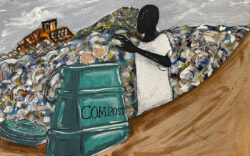Daydreams and Memories: “The Crossroads of Memory: Carroll Cloar and the American South”—currently on display at the Georgia Museum of Art through Jan. 5—includes 70 of the approximately 800 paintings Cloar created over his lifetime.
Drawing on personal stories, memories and family photographs to present scenes of rural life, familiar landmarks and sprawling landscapes, Cloar creates a timeless, dream-like vision of the American South. Emulating pointilism, which grew out of the French Impressionist movement, Cloar achieves an incredible level of layered texture and minute detail through tiny dots of saturated contrasting color. He combines these influences of Regionalism and pointillism with the strange, disconcerting themes of Surrealism, blurring the lines between reality and imagination.
Perhaps more than any other style, Cloar’s works are best identified as belonging to Magic Realism, a style combining familiar, believable images from the everyday world with elements of fantasy through distorted perspectives and odd juxtapositions. “Hallowe’en,” for example, mixes the menace of hooded Ku Kluxers along the horizon with the innocence of a masked trick-or-treater running through a field. The full moon, an abandoned Victorian house and washes of color beneath thinly painted areas create an eerie, ghost-like presence.
A special gallery talk scheduled for Thursday, Oct. 17 at 5:30 p.m. will be led by Patty Bladon, who was a close friend of Cloar’s for over 20 years and is co-author of the forthcoming book The Last of the Old America: The Art and Life of Carroll Cloar. Other related events include a program with Grandparents Raising Grandchildren on Saturday, Oct. 26 and a Family Day on Sunday, Nov. 10.
All Abstract: “Cercle et Carré and the International Spirit of Abstract Art”—also currently on display at the Georgia Museum of Art through Jan. 5—is the first major exhibition in the U.S. devoted to the activities of Cercle et Carré, a 1930s modernist group created by Belgian artist Michel Seuphor, Uruguayan-Catalan artist Joaquín Torres-García and Catalan-American artist Pierre Daura.
The highly democratic group, whose name translates as Circle and Square, consisted of approximately 80 emerging and established international artists and formed largely in opposition to Surrealism. The works of artists such as Wassily Kandinsky, Piet Mondrian, Le Corbusier and Kurt Schwitters reflect a variety of media and styles, touching on Cubism, Purism, Constructivism, De Stijl and Dadaism.
Cercle et Carré is best known for publishing a periodical and staging an international exhibition of abstract art in Paris in 1930, which included 130 works by 46 members of the group. Though Cercle et Carré is seldom discussed in depth academically, its exhibition is now recognized as a landmark event in the history of modernism and abstraction. Organizing itself off of the pieces included in the Paris exhibit, “Cercle et Carré and the International Spirit of Abstract Art” includes works by 31 of the 46 original participating artists.
The exhibition, curated by Pierre Daura Curator of European Art Lynn Boland, presents a very rare view of a diverse array of abstract works that have not been discussed critically in relation to one another in over 80 years. Complementing the primary resources in GMOA’s Pierre Daura Center’s archive and collection, the exhibit brings new research to light.
Forward Motion: In conjunction with “Cercle et Carré and the International Spirit of Abstract Art,” the Georgia Museum of Art will present “L’objet en mouvement: Early Abstract Film,” which includes a selection of films discussed by essayists in the third issue of Cercle et Carré’s journal.
Swedish avant-garde artist Viking Eggeling’s Symphonie diagonale uses paper cutouts, tinfoil figures and frame-by-frame photography, serving as one of the earliest works of animation. Fernand Léger’s Le Ballet méchanique is a Dadaist film that flashes chaotically through over 300 mechanical and repetitive images, emphasizing the world in motion. Man Ray’s Emak-Bakia demonstrates several of the artist’s techniques such as Rayographs, soft focus, stop motion and double exposure.
Baring it All: “Misfits,” a sculptural installation by Christina West, assistant professor of art at Georgia State University, combines bright pink, smaller-than life sculptures in the center of a large box lined with two-dimensional painted figures in various degrees of nakedness against black walls. The immersive installation allows viewers to place their faces against holes from the outside, putting them onto the body of a painted figure, or they can enter the box to be fully surrounded.
Many artworks present idealized versions of the human form, commonly youthful and attractive figures with fit frames, yet West’s figures reflect a wider range of ages and body types, offering a more realistic depiction of physical diversity and the current average. With no clear narrative, scenes like a man pulling his shirt over his head and a woman undressing as a man crouches nearby create a high level of vulnerability and frankness between the figures and viewers.
“Misfits” will be on display in Gallery 307 of the Lamar Dodd School of Art through Friday, Oct. 18. The gallery is open Monday–Friday, 9 a.m.–5 p.m.
Atlas Art: Rachel Clarke, professor of electronic art at California State University, Sacramento, explores in “Unmapping,” similarities between the natural and constructed worlds through a collection of drawings and digital videos, two of which are accompanied by electronic compositions by Stephen Blumberg. Pulling patterns from digital networks as well as anatomical, botanical and cellular diagrams, her map-like imagery highlights the dynamic relationships between man-made and biological systems as technology progresses.
“Unmapping” will be on display in Gallery 101 of the Lamar Dodd School of Art through Friday, Nov. 1.
Utilizing Space: Current Lamar Dodd Distinguished Professorial Chair Kendall Buster will unveil new models and drawings produced during her guest residency in her upcoming exhibition, “Miniature Monumental.” Buster, a professor in the department of sculpture and extended media at Virginia Commonwealth University, creates installations influenced by microbiology and architectural design. “Miniature Monumental,” which will provide an intimate look into her studio process, seeks to present site-specific projects where scale is indeterminate.
The opening reception is Thursday, Oct. 24, 6–8 p.m., and the installation will be on display in Gallery 307 of the Lamar Dodd School of Art through Tuesday, Nov. 12.
Like what you just read? Support Flagpole by making a donation today. Every dollar you give helps fund our ongoing mission to provide Athens with quality, independent journalism.









